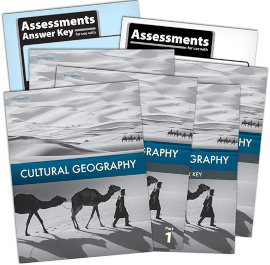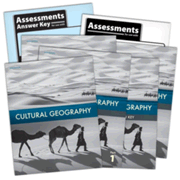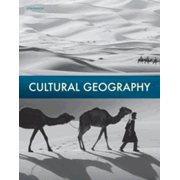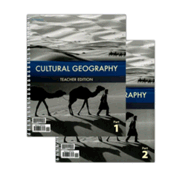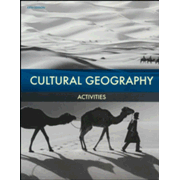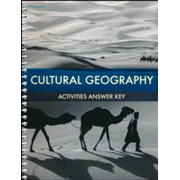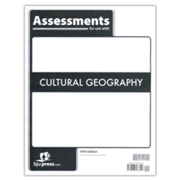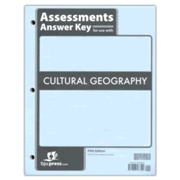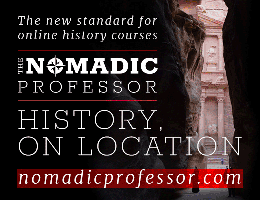The fifth edition (2021) of BJU Press’s Cultural Geography course teaches about both geography and cultures from around the world from a biblical Christian (Protestant) point of view.
Cultural Geography is suggested for grade nine as a full-year course. While it could be used a different year in high school, it makes sense to use before studying world history since it gives students underlying geographical knowledge which then makes it easier to understand the dynamics of world history.
The book has been significantly rewritten from previous editions, reflecting the huge geographic and cultural shifts that are continually occurring. The content of the course aligns with the 18 standards created by the Geography Education National Implementation Project.
The Cultural Geography Subject Kit includes the student text, the two-volume teacher’s edition, the student activities manual, assessments (one for each of the course’s 24 chapters), and answer keys for the activities manual and the assessments.
The teacher’s edition and the student text are also available as eTextbooks. The student eTextbook includes the option for students to listen rather than read. However, the illustrations in the textbook are critical, so students who listen also need to view the illustrations.
Student Textbook and Activities Book
The large student textbook (almost 600 pages) is lavishly illustrated with full-color maps, photos, and infographics. The textbook’s 24 chapters are arranged into eight units, with two to five chapters per unit. Maps, a glossary, and an index are at the end of the book.
The beginning of each chapter lists three “Big Ideas” that will be covered. Then each section within a chapter begins with an “Essential Question” indicating the main idea to be covered in that section. A set of “Guiding Questions” for each section further breaks the main idea for each section into subtopics to be covered, posing them as questions to pique students’ interest. All three features help focus student attention on the most important information. In addition, key terms students are expected to know are in bold.
Special sections within some chapters, titled “Beliefs,” explain religions practiced within the cultures being studied. Other special sections, titled “Case Study,” explore special topics, such “Oso Landslide” (in Oso, Washington) and “Volcanoes in Iceland.” Yet another type of special section, titled “Global Impact,” addresses topics, such as “Terrorism” and “The Olympics.”
As is typical of BJU Press textbooks, there are several sets of section review questions within each chapter and additional questions at the end of each chapter. The Chapter Reviews include a summary of key ideas, a list of terms to know, and questions under four headings: Making Connections, Developing Geography Skills, Thinking Critically, and Living in God’s World. These questions include comprehension questions, occasional activities (e.g., drawing maps, researching online), and questions requiring critical thinking and personal responses. Answers are in the teacher’s edition.
The four chapters in the first unit provide background and foundational information for the rest of the course. The first chapter begins with a very brief discussion of how the Bible should inform students’ thinking about geography. One of the summary statements on page 16 exemplifies the worldview perspective that applies throughout the course. It states, “The Creation Mandate plays an essential role in understanding geography and provides the means by which God intended to populate the earth. Cultural diversity abounds and must be analyzed from a biblical perspective.” The first chapter also explains different aspects of geography; globes, maps, and technologies used in geography; how to use the tools of a geographer; and an overview of cultures.
Chapter Two introduces physical geography by teaching about the structure of the earth, earth’s physical systems (e.g., water, atmosphere), processes that shape the earth (earthquakes and volcanoes), types of landforms, bodies of water, and how people interact with land and water. The third chapter focuses on climate and includes man’s responsibility to the environment. Chapter Four sets the stage for the rest of the course with the study of four broad topics: cultures, political geography, economic geography, and world population and cities.
The rest of the course covers one geographic area at a time as listed:
- Unit 2 - the United States and Canada
- Unit 3 - Latin America
- Unit 4 – Europe and Russia
- Unit 5 – Africa
- Unit 6 – The Middle East and Central and South Asia
- Unit 7 – East and Southeast Asia
- Unit 8 – Oceania and Antarctica
The chapters within each of these units break each topic down into slightly smaller geographic areas. The content in every chapter ranges through geography and culture, often making connections to historical events.
With the second unit, students begin a journaling project where they write what they know and think about each geographic area both before and after studying it.
As I mentioned previously, the textbook is written from a biblical worldview. For instance, Chapter 8 includes a Chapter Review question that reads, “How does a biblical worldview help make sense of Chile’s economic success compared to Venezuela’s economic failure?” (p. 186). When it discusses other world religions, it does so through a Protestant lens. Some worldview content also arises from discussions and videos suggested in the margins of the teacher’s edition rather than from the student text or the Homeschool Hub, so it’s up to parents to decide whether to present the material.
The student activities book works hand in hand with the textbook with questions, map work, charts to complete, and enrichment activities that go beyond the textbook. Both the teacher’s edition and the Homeschool Hub let you know when to use pages in the activities book. The activities manual has its own answer key.
Teacher’s Edition and Homeschool Hub
The teacher’s edition consists of two spiral-bound books that contain reduced images of the student text pages and serves as your answer key for section and chapter review questions. It also provides a great deal of helpful information for parents who want to directly teach the course. It has discussion questions, sometimes with suggested responses or aspects to bring up. It also has suggestions for videos and other online resources you might use. The fifth edition now also includes suggestions for differentiated instruction. Homeschooling parents might find the teacher’s edition too cumbersome to work with, and they might find the free Homeschool Hub™ much more practical. The Hub has a course gradebook and simplified lesson plans that occasionally recommend online videos. Also on the Hub is a downloadable, 43-page list of web links.
I encourage you to take advantage of the extra resources and suggestions in the teacher’s edition and on the Homeschool Hub. I realize that some homeschooling parents will choose to have their students complete this course on their own, and that will work. However, it isn’t likely to be as interesting if you leave out the discussions and extra activities.
Summary
BJU Press's Cultural Geography course brings meaning to the study of geography and cultures by addressing questions related to human flourishing, stewardship of the environment, and the influence of religious beliefs. It does an excellent job of covering factual information, while also prodding students to think deeper as to why it matters.

